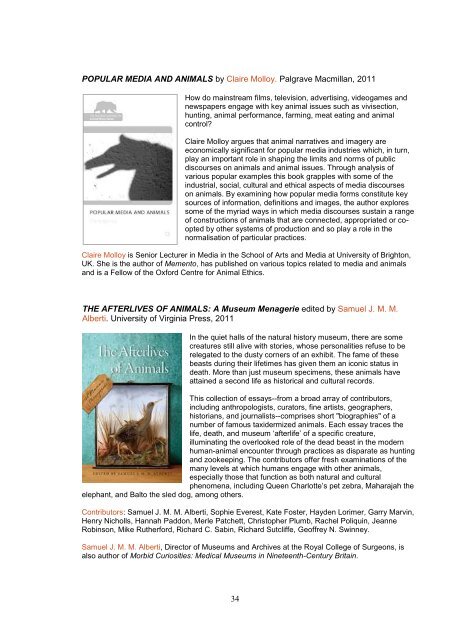News Bulletin - Australian Animal Studies Group
News Bulletin - Australian Animal Studies Group
News Bulletin - Australian Animal Studies Group
Create successful ePaper yourself
Turn your PDF publications into a flip-book with our unique Google optimized e-Paper software.
POPULAR MEDIA AND ANIMALS by Claire Molloy. Palgrave Macmillan, 2011<br />
How do mainstream films, television, advertising, videogames and<br />
newspapers engage with key animal issues such as vivisection,<br />
hunting, animal performance, farming, meat eating and animal<br />
control?<br />
Claire Molloy argues that animal narratives and imagery are<br />
economically significant for popular media industries which, in turn,<br />
play an important role in shaping the limits and norms of public<br />
discourses on animals and animal issues. Through analysis of<br />
various popular examples this book grapples with some of the<br />
industrial, social, cultural and ethical aspects of media discourses<br />
on animals. By examining how popular media forms constitute key<br />
sources of information, definitions and images, the author explores<br />
some of the myriad ways in which media discourses sustain a range<br />
of constructions of animals that are connected, appropriated or coopted<br />
by other systems of production and so play a role in the<br />
normalisation of particular practices.<br />
Claire Molloy is Senior Lecturer in Media in the School of Arts and Media at University of Brighton,<br />
UK. She is the author of Memento, has published on various topics related to media and animals<br />
and is a Fellow of the Oxford Centre for <strong>Animal</strong> Ethics.<br />
THE AFTERLIVES OF ANIMALS: A Museum Menagerie edited by Samuel J. M. M.<br />
Alberti. University of Virginia Press, 2011<br />
In the quiet halls of the natural history museum, there are some<br />
creatures still alive with stories, whose personalities refuse to be<br />
relegated to the dusty corners of an exhibit. The fame of these<br />
beasts during their lifetimes has given them an iconic status in<br />
death. More than just museum specimens, these animals have<br />
attained a second life as historical and cultural records.<br />
This collection of essays--from a broad array of contributors,<br />
including anthropologists, curators, fine artists, geographers,<br />
historians, and journalists--comprises short "biographies" of a<br />
number of famous taxidermized animals. Each essay traces the<br />
life, death, and museum ‗afterlife‘ of a specific creature,<br />
illuminating the overlooked role of the dead beast in the modern<br />
human-animal encounter through practices as disparate as hunting<br />
and zookeeping. The contributors offer fresh examinations of the<br />
many levels at which humans engage with other animals,<br />
especially those that function as both natural and cultural<br />
phenomena, including Queen Charlotte‘s pet zebra, Maharajah the<br />
elephant, and Balto the sled dog, among others.<br />
Contributors: Samuel J. M. M. Alberti, Sophie Everest, Kate Foster, Hayden Lorimer, Garry Marvin,<br />
Henry Nicholls, Hannah Paddon, Merle Patchett, Christopher Plumb, Rachel Poliquin, Jeanne<br />
Robinson, Mike Rutherford, Richard C. Sabin, Richard Sutcliffe, Geoffrey N. Swinney.<br />
Samuel J. M. M. Alberti, Director of Museums and Archives at the Royal College of Surgeons, is<br />
also author of Morbid Curiosities: Medical Museums in Nineteenth-Century Britain.<br />
34


